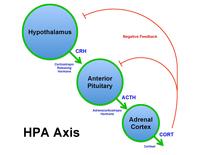
Photo from wikipedia
Background: Healthy people have a leftward spatial attentional bias, called pseudoneglect. Individuals with end-stage renal disease (ESRD) who are receiving hemodialysis often demonstrate an increase in their leftward spatial attentional… Click to show full abstract
Background: Healthy people have a leftward spatial attentional bias, called pseudoneglect. Individuals with end-stage renal disease (ESRD) who are receiving hemodialysis often demonstrate an increase in their leftward spatial attentional bias. Whereas a successful kidney transplant often improves the cognitive functions of individuals who previously received hemodialysis, the effect of a kidney transplant on this abnormal allocation of spatial attention has not been investigated. Objective: To investigate the effects of kidney transplant on individuals who were being treated with dialysis and had an increase in their left spatial attentional bias. Method: The performance of 20 hemodialyzed individuals with ESRD on the line bisection test was compared to that of 17 demographically matched individuals with ESRD, who had received a kidney transplant, and 23 demographically matched healthy controls (HC). Results: All of the participants exhibited a left spatial bias on the line bisection task. When compared with the HC, the hemodialyzed individuals demonstrated a significantly greater left spatial bias. There was, however, no difference in spatial bias between the HC and the individuals who had received a kidney transplant. Conclusion: A successful kidney transplant can improve patients’ abnormal leftward allocation of spatial attention. However, future studies are needed to better understand the mechanisms of this spatial attentional bias in hemodialyzed individuals and the normalization of bias following transplantation.
Journal Title: Cognitive and Behavioral Neurology
Year Published: 2022
Link to full text (if available)
Share on Social Media: Sign Up to like & get
recommendations!